Tippler Pigeon: Bird that Flies Like a Butterfly
In 1893, a man named W. Jolly claimed he bred a pigeon for 56 years. The claim is recorded in Wendell Levy’s book “The Pigeon”. However, the pigeon had long elongated feathers and could fly like a butterfly.
This pigeon breed was Tipplers, which is now famous for pigeon competition. Some claim they are from England, some claim they are from Europe. Many argue that Tipplers are an evolved version of Madrasi Highflyers.
Check out the rest of the article, where I debunk the origin story, features, traits, breeding and maintenance of Tippler Pigeons.
Tippler Pigeon Profile
| Name | Tippler Pigeon |
|---|---|
| Scientific Name | Columba livia domestica |
| Common Names | Tippler Pigeon |
| Origin | United Kingdom, 1845 |
| Size | 10 to 12 inches |
| Weight | 10 to 14 ounces |
| Lifespan | 15 years |
| Physical Features | Sleek, fan-shaped tail, medium sized |
| Temperament | Inquisitive, sociable and intelligent |
| Behavior | Docile and no migratory behavior, High flying endurance |
| Special Features | Extended flying capability (18+ hours). |
| Breeding and Maintenance | Selecting healthy pigeons, forming strong bonds |
| Common or Popular Varieties | 01. Macclesfield Tipplers 02. Manchester Tipplers 03. Irish Blue Tipplers |
Interested in similar topics on pigeon breed:
Overview
Tippler pigeon is a domesticated breed that was bred for high-endurance flying. It has other varieties as Macclesfield Tippler, Manchester Tippler and Irish Blue Tippler.
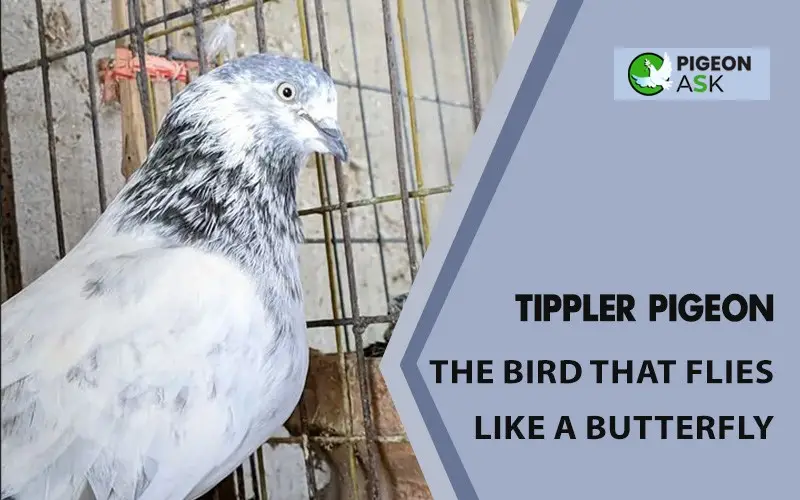
They are smart and easily follow human commands. Tipplers are popular for pigeon competition. In 2023, fancier J.Flee young Tippler made the record of winning the young Tippler race at just 19 minutes and 44 seconds.
History And Origins of Tippler Pigeons
The history and origins of tippler pigeons remain somewhat elusive, but insights gleaned from various web sources offer intriguing glimpses into their evolution.
This breed of domestic pigeons traces its roots back to 19th-century England, born from the deliberate crossbreeding of the French Cumulate and the Indian highflyer.
The primary ambition of these breeders was to refine the distinctive butterfly action of the wings, a trait instrumental in enabling the Tippler’s remarkable long-duration flights.
This led to the emergence of diverse types and varieties, each bearing names that pay homage to their origins or influential breeders—Macclesfield, Hughes, Lovatt, Shannon.
Trained to soar in groups of three or more, these tippler pigeons engage in spirited competition, striving to outlast one another in the air for prolonged periods.
Their average flight times reportedly range from 14 to 19 hours, although some accounts boast an astounding endurance of up to 22 hours.
Physical Characteristics And Features
Tipplers look like regular pigeons, but they have a fan-shaped tail. Moreover, they come in different colors.
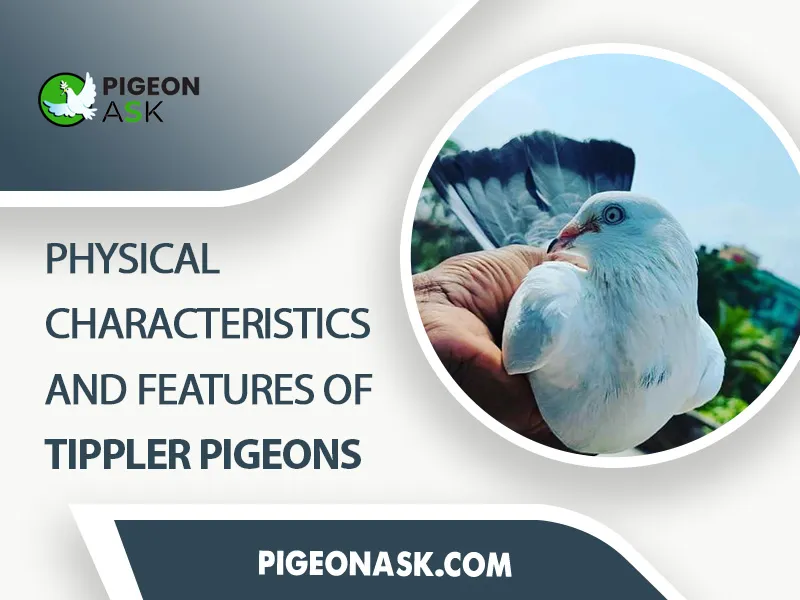
Here is a table summarizing the physical characteristics and features of the Tippler pigeon –
| Characteristic | Description |
|---|---|
| Feathers | Provide insulation, aerodynamic power and colors for communication and camouflage |
| Beak | Short and curved, used for feeding and grooming |
| Wings | Long and narrow, designed for efficient flight and endurance |
| Tail | Ornate feathers developed primarily for courtship display |
| Feet | Small and adapted for perching |
| Eyes | Large and located on the sides of the head, providing a wide field of vision |
| Cere | Fleshy area above the beak that contains the nostrils |
| Crop | Muscular pouch in the throat that stores food before digestion |
| Plumage | Can vary in color, ranging from grey to red, yellow and blue |
| Size | Medium-sized, leaner and smaller compared to Homer pigeons |
| Neck | Slender and flexible, allowing for efficient flight |
| Flight Muscles | Well-developed and adapted for endurance flying |
| Keel | Prominent ridge on the breastbone that provides attachment for the flight muscles |
| Lifespan | 5 years in the wild and up to 15 years in captivity |
Appearance
Tipplers are a muscular breed of pigeon with a compact body and a long, slender neck. They have a deep keel and a broad chest, which provides them with ample space for their large lungs.
Tipplers have medium-sized aerodynamic wings. They always maintain a straight posture and streamlined shape. However, they look like regular pigeons except for the elongated tail.
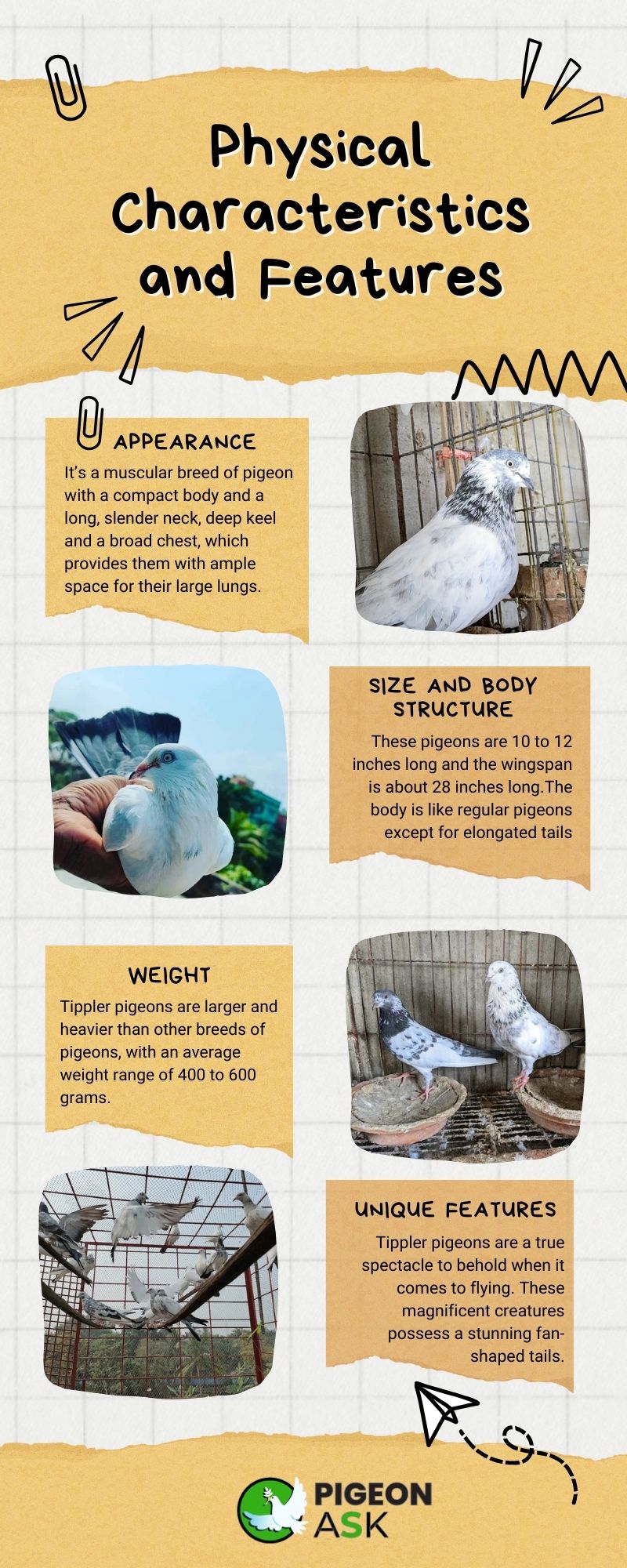
There are different types of Tippler pigeons, including Gordon Hughes, Irish Blue, Lovatt and Macclesfield Tipplers.
Irish Blue ones have white and blue plumage. Lovatt has white and black and the Macclesfield has white and grayish plumage.
Size and Body Structure
These pigeons are 10 to 12 inches long and the wingspan is about 28 inches long.
The body is like regular pigeons except for elongated tails. However, Tipplers have medium-length necks and short beaks.
Weight
Tippler pigeons are larger and heavier than other breeds of pigeons, with an average weight range of 400 to 600 grams.
Their added weight lets them stay in the air longer, meeting their breed’s need for extended flights.
Heavier pigeons have more muscle mass, which gives them more power to flap their wings.
Another possibility is that heavier pigeons have more fat stores, which they can use for energy during flight.
Additionally, heavier pigeons may have a more favorable wing loading, which is the ratio of their weight to their wing area. A lower wing loading means that the pigeon has to generate less lift to stay in the air, which can conserve energy.
Unique Features
Tippler pigeons are a true spectacle to behold when it comes to flying. These magnificent creatures possess a stunning fan-shaped tails.
It adds a touch of elegance and style and also helps them glide through the air with remarkable finesse and poise. The exact speed at which they fly is a mystery.
It’s believed that they maintain an average speed of no more than 30 mph. This may seem modest, but it is quite impressive given their other abilities.
What truly sets Tippler pigeons apart from other birds is their unmatched endurance. They are the marathon runners of the avian kingdom, capable of flying non-stop for a staggering 22 hours straight.
This feat is not only impressive but also a testament to their incredible strength, stamina and unwavering determination.
Another remarkable trait of these birds is their unique drinking style. They don’t follow the conventional sipping routine. Instead, they continuously drink without having to lift their heads.
It’s almost as if they are in complete sync with the air around them, not wanting to disrupt their flight even for a moment. Tippler pigeons are truly the rockstars of the pigeon world and their flying abilities and habits are a sight to behold.
Common Variations in Colors and Markings Across Different Species
Among the diverse spectrum of tippler pigeons, several variations stand out, each flaunting unique traits and origins.
The Gordon Hughes Tipplers, conceived in Derby, England, are synonymous with endurance, clocking over 19 hours in flight numerous times.
Meanwhile, the Irish Blue Tipplers sport a rare and stunning blue and white plumage, native to Ireland, prized for their remarkable endurance and flying prowess.
Jack Boden Tipplers, a rare breed esteemed for exceptional flying abilities, trace their origin to a renowned breeder, Jack Boden.
In Yorkshire, England, the Sheffield Tipplers grace the skies, usually donning red and yellow hues, with several 20-hour flight records to their name.
German Show Tipplers, also dubbed Exhibition Tipplers, boast varied colors and patterns, from bronze to silver and checker, bred specifically for display purposes.
The Pakistani Tipplers, known as Kabootar in Pakistan and India, exhibit a streamlined physique and enduring flight capabilities.
And finally, the Amsterdamse Tipplers from the Netherlands flaunt a striking black and white wing and tail pattern, earning them the moniker Dutch Tipplers.
These distinct variations collectively paint a vivid portrait of the diverse and captivating world of tippler pigeons.
Here’s a table summarizing the common variations of tippler pigeons and their unique features –
| Variation | Origin | Distinctive Features |
|---|---|---|
| Gordon Hughes Tipplers | Derby, England | Flown over 19 hours multiple times, known for endurance |
| Irish Blue Tipplers | Ireland | Stunning blue and white plumage, prized for endurance and flying abilities |
| Jack Boden Tipplers | – | Renowned for exceptional flying abilities and endurance |
| Sheffield Tipplers | Yorkshire, England | Usually red and yellow, multiple 20-hour flight records |
| German Show Tipplers (Exhibition Tipplers) | – | Bred for exhibition, diverse colors – bronze, silver, checker |
| Pakistani Tipplers (Kabootar) | Pakistan and India | Streamlined appearance, noted for endurance |
| Amsterdamse Tipplers (Dutch Tipplers) | Netherlands | Distinctive black and white wing and tail pattern |
Distribution And Habitat
Tippler pigeon breeds are found among pigeon fanciers and they can live in both urban and rural areas.
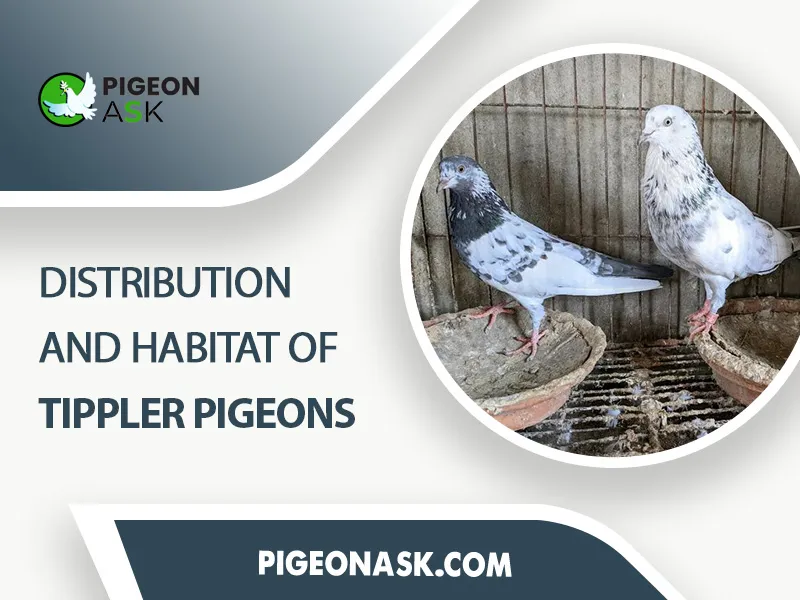
Geographic Distribution
Unlike most pigeon breeds, Tipplers do not thrive in wild environments. Instead, they exist almost exclusively in domestic spaces cared for by pigeon fanciers.
Tipplers can be found all over the world despite their lack of suitability for wilderness survival. Their global presence is a testament to the dedication of the pigeon fancier community.
Habitat Preferences
In their natural habitat, Tipplers tend to favor semi-open areas with cliff dwellings. However, domesticated Tipplers take well to enclosed spaces like roomy lofts or coops.
When kept as pets, they display admirable adaptability, thriving in close company with humans.
Urban and Rural Habitats
Tipplers are highly adaptable pigeons that can make their homes in both rural and urban environments, given proper housing. In rural areas, they reside comfortably in barns or lofts on farms.
Meanwhile, in cities, they are content living in rooftop coops, backyard enclosures, or urban lofts.
Migration and Seasonal Movements
Pet Tipplers don’t migrate anymore – they’ve lost that instinct after so much domestication.
Since they chill in coops and lofts with their human owners looking after them, they never need to pack up and head to warmer areas when the weather turns.
Even non-pet pigeons usually just find a nice spot to ride out winter rather than migrate someplace new. However, Tipplers stay put in one comfy home no matter the season.
Threats and Conservation Status
The conservation status of tippler pigeons, notably absent from the IUCN Red List, suggests they aren’t deemed endangered.
However, they grapple with various threats like habitat loss, predation by hawks, eagles and cats, diseases and human interference.
These intelligent birds necessitate secure living spaces like pigeon lofts to evade predators and perform tricks, while their specialized breeding for flying prowess raises concerns of overexertion, dehydration and accidents during flights.
Within the pigeon racing domain, unethical practices like doping, culling and smuggling loom as detrimental factors, risking the health and welfare of these pigeons.
The pressure to meet certain standards in competitions often leads to the abandonment or illegal transportation of these birds, potentially violating animal welfare laws and regulations.
Protecting these pigeons necessitates not just their physical well-being but also ethical considerations within the realm of pigeon racing to ensure their enduring presence and health in our shared environment.
Behavior And Traits
Tipplers are intelligent, trainable birds known for competing in pigeon racing events. They also tend to be quite friendly with and affectionate toward humans.
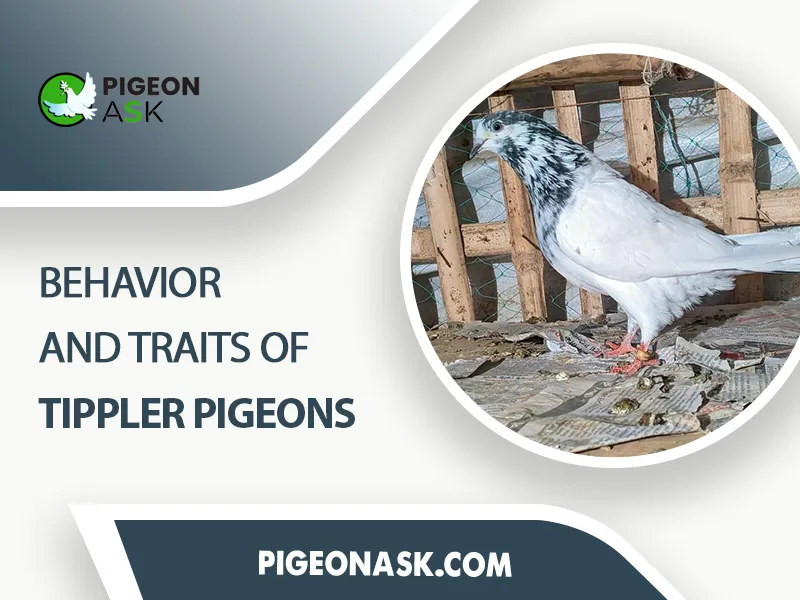
Their high intellect and affable nature make them well-suited as family pets, even for children. For these reasons, they are desirable companions to pigeon fanciers.
Common Personality Traits
These attentive pigeons are considered one of the most intelligent breeds. Tipplers can quickly pick up on human training and cues.
They enjoy showing off newly mastered skills and flourish under positive attention. With early socialization, these pigeons bond strongly with their owners and spend ample time interacting with their human caretakers.
Differences Between Wild and Domesticated
There is limited information on wild Tipplers since the breed is domesticated. Pet Tipplers have been selectively bred to thrive in human company and rely on caretakers to meet their survival needs.
Having lost many of their natural survival instincts, Tipplers feel safest and most comfortable housed in a human home.
Diet
Their diet typically consists of traditional pigeon fare like seeds, grain and commercial bird feed. Tipplers also enjoy fresh greens, insects and human food scraps. They are less skilled than wild pigeons at self-foraging for sustenance.
Temperament
Tippler pigeons are generally very good around people and other animals. They are not aggressive birds and are often quite friendly and affectionate.
These high-endurance pigeons are very active birds that enjoy playing and exploring their surroundings. They are often the first to try new things and are always up for a game of chase.
However, tipplers can be quite territorial, especially when it comes to their food and nesting sites. They may become aggressive towards other pigeons or animals that they perceive as a threat.
Flight and Racing
In-flight competitions, tripper pigeons may fly up to 14 hours at lengths, circling and showcasing noteworthy aerial endurance. Their flight training begins at a young age to prepare the birds both physically and mentally for racing later on.
Homing Ability
Tipplers possess great flying stamina over long distances but are believed to lack strong homing instincts. They can orient themselves from closer locales but reportedly get lost when released from remote, unfamiliar areas.
Their precise homing range thresholds remain unspecified. Given their poor navigation skills, Tipplers should always be housed securely to prevent permanent escape and going astray.
Nesting, Breeding and Courtship
Common courtship displays give way to nest-building and egg-laying in home lofts and coops.
Both male and female Tipplers make affectionate, attentive parents, sharing egg incubation and squab feeding duties. Their strong breeding instincts fully manifest in the comfortable domestic environment.
Breeding And Maintenance
Making Tippler pigeon babies means handpicking the healthiest, coolest birds, giving them a nice place to nest and keeping a close eye on their love lives for those perfect little offspring.
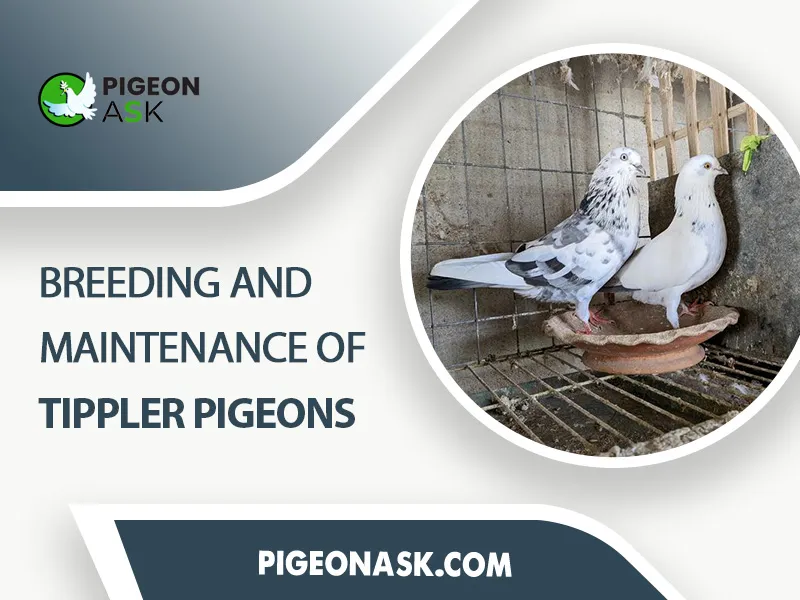
Breeding Age
Tippler pigeons reach breeding readiness around 8 months to 1 year of age.
Although these pigeons can breed as early as 4-6 months, practitioners advise waiting for maturity to ensure successful reproduction.
Pairing Up for Success
Breeding Tippler pigeons is no walk in the park! Having three pairs of breeders is the key to creating a continuous line of potential champions.
Keeping an eye on how they’re making babies is also important. Sometimes, separating boy and girl pigeons can stop them from having too many babies.
It’s best not to let closely related pigeons make babies to avoid problems with their health.
The Dance of Love
When Tippler pigeons fall in love, they don’t hold back! Their mating dance is a graceful ballet that would make even seasoned dancers jealous.
They pair up, perform intricate moves and signal the start of a journey towards creating the next generation of exceptional fliers.
Breeding Information
Health checks are crucial when selecting breeding pairs. Choose Tipplers with strong flight records and vigor. Once situated in the loft, pairs readily mate and lay eggs.
Tipplers can produce multiple clutches annually. However, egg incubation ranges from 16 to 18 days, with squabs fledging at around 28 days. Parent birds diligently incubate eggs, but human assistance helps ensure squab survival.
Looking After Them
Tippler pigeons don’t need a lot of taking care of when it comes to eating and exercising, but they do need regular practice flying to stay good at it.
Making sure they are getting to eat good pigeon food, veggies and always have clean water to drink is enough. Plus, they’re healthy and not stressed, which helps prevent them from getting sick or worried.
Training and Flying
Tippler pigeons need regular practice to keep their flying skills sharp. They’re pretty good at flying together in groups and doing fancy tricks in the air.
But just like athletes, they need to be healthy and really want to fly to do well.
Conclusion
Tipplers’ poor navigation skills mandate caretaker diligence: even momentary inattention risks losing these vulnerable, domesticated birds. With a commitment to their specialized care, Tipplers fully blossom as affectionate companions.
For more fascinating facts and helpful tips about gorgeous pigeon breeds, be sure to follow us on Facebook, Twitter and Google News!
